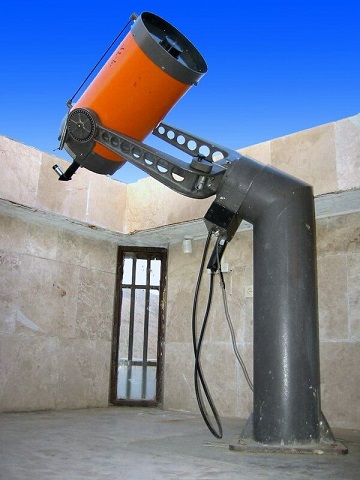ABOUT US
Biruni Observatory was established in 1977 to become a center for education and research in astronomy and astrophysics. Over the last four decades, the activities in the observatory have been divided into two major educational and research groups. The research is done in theoretical and observational divisions. The observational groups basically conduct research by gathering data using different telescopes at the observatory or by collaboration with international teams. Variable stars and extragalactic studies are the main current fields of observational research at Biruni Observatory. The main 20 inch (51 cm) telescope besides 14, 12, 11 and 8-inch telescopes are equipped with a photometer (PMT) and CCD cameras for observing variable stars.
In the theoretical division, research is done in astrophysics and cosmology, particle astrophysics, binary stars, construction of the neutron stars, stellar dynamics and evolution, black holes, the theory of general relativity and dark energy. Biruni Observatory publishes significant scientific papers and articles in international journals each year. Doctoral and master students use the facilities to conduct research in astronomy, astrophysics and cosmology to join the other universities and institutes for education and research. The observatory has a communication network with other observatories in and outside Iran. Some major Iranian universities let their Ph.D. and master students use the facilities of the observatory for their research projects. The observatory is also active in organazing workshops and meetings each year. In its 40th anniversary, the center is now taking steps to expand national and international collaborations. For this, the growth of research groups, new programs for educational courses (graduate and undergraduate) and participation in international projects are considered.
The Biruni Observatory is run by Shiraz University and financed by the Office of Research of Shiraz University.

20″ Telescope
EQUIPMENT:
Current Facilities and instruments in Biruni Observatory include the following:
20 inch Cassegrainian reflective telescope (built by Astro Mechanics).
14 inch Schmidt-Cassegrainian reflective telescope (Celestron).
12 inch Schmidt-Cassegrainian reflective telescope (Meade).
11 inch Schmidt-Cassegrainian reflective telescope (Celestron).
8 inch Cassegrainian reflective telescope (Vixen).
8 inch Schmidt camera (used for photography).
Two 5 inch Schmidt-Cassegrainian reflective telescopes (Celestron).
4.5 inch Newtonian reflective telescope.
Two photomultiplier tubes (PMTs)
Two CCD camers (Meade and SBIG)
Two DSI camers (Meades)
Graduate students, as well as the members of the of the Astronomy Club of Students regularly use the facilities for their projects.

14″ Telescope
OUTREACH ACTIVITIES:
The observatory conducts public tours two to three times a week. The attendants usually start the tour with an educational presentation, visiting different parts of the observatory and finally observe the sky with an 8-inch telescope. The observatory also conducts special tours for the invited guests, staffs and faculty of Shiraz University. The observatory participates in educational TV programs, conducts projects for the vision of the lunar crescent and the religious lunar and solar times and consults in regards to astronomical projects.
Educational courses in Astronomy for public are also organized regularly each year.
LOCATION:
The Biruni Observatory is located in Eram complex over a hill in north of Shiraz. The building is geographically located at the longitude of 52 degrees, 30 minutes and 16 seconds and the latitude of 29 degrees, 39 minutes and 01 seconds. It is 1740 meters above the sea level and about 180 meters above the City of Shiraz. The area of the building is about 400 square meters in a 3 story building, in an area of a complex which is about 5000 square meters. The structure of the building is from concrete cement which can withstand earthquakes up to 8.5 in Richter scale. The building is constructed in a hexagonal shape and comprises special architectural innovations. The observatory consists of the main office, the hall, offices, photography laboratory, workshop, coffee shop, all in a garden with its own parking lot and facilities. The observatory is about two kilometers from the main gate of the Eram Paradise and easily accessible by car or on foot.
